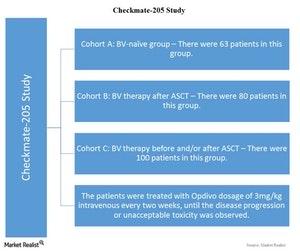Data from the Checkmate-205 Study Evaluating Opdivo
Follow-up data were released from the Checkmate-205 study. It evaluated long-term effects of PD-1 inhibitors in patients with classical Hodgkin Lymphoma.
June 20 2017, Updated 2:06 p.m. ET

Opdivo
Bristol-Myers Squibb’s (BMY) Opdivo (nivolumab) is a human PD-1 (programmed death-1) blocking antibody developed as part of an alliance with Ono Pharmaceutical. The drug is approved to treat various forms of cancer, which we’ll discuss in the next part.
Extended follow-up data
The company released extended follow-up data on June 16, 2017, from the Checkmate-205 study. The study evaluated long-term effects of PD-1 inhibitors in patients with classical Hodgkin Lymphoma. It’s the most follow-up data for PD-1 inhibitors for the treatment of classical Hodgkin Lymphoma.
Checkmate-205 study
The Checkmate-205 study is a Phase 2, multi-cohort study evaluating the ORR (objective response rates) and DOR (duration of response rates) for Opdivo in patients with a failed ASCT (autologous stem cell transplant) for the treatment of classical Hodgkin Lymphoma, irrespective of the history of use of the drug BV (brentuximab vedotin).
Patients were treated with an Opdivo dosage of 3mg/kg intravenous every two weeks until disease progression or unacceptable toxicity was observed in patients.
From 243 patients enrolled at the trial stage, 77% of the patients had stage III or higher refractory or relapsed classical Hodgkin lymphoma. However, at the 16-month and 23-month follow-up, only 97 patients remained on the treatment of Opdivo 3mg/kg intravenous dosage.
Data received from the Checkmate-205 study are as follows:
- Cohort A: BV-naïve group – There were 63 patients in this group. During the median follow-up at 19 months, the ORR was 65%, while a complete response was observed in 29% of the patients. Also, the median DOR was 16 months, while the PFS (progression free survival) was 18.3 months.
- Cohort B: BV therapy after ASCT – There were 80 patients in this group. During the median follow-up at 23 months, the ORR was 68%, while a complete response was observed in 13% of the patients. The median DOR was 16 months, while the PFS was 14.7 months.
- Cohort C: BV therapy before and/or after ASCT – There were 33 patients with BV therapy before ASCT, 58 patients with BV therapy after ASCT, and nine patients with BV therapy before and after ASCT. The total number of patients was 100 for this group. During the median follow-up at 16 months, the ORR was 73%, while a complete response was observed in 12% of the patients. The median DOR was 15 months, while the PFS was 11.9 months.
BV is marketed by Seattle Genetics (SGEN) under the brand name “Adcetris.”
To divest the risk, investors can consider ETFs like the Vanguard Healthcare ETF (VHT), which holds 2.8% of its total assets in Bristol-Myers Squibb. VHT also holds 2.7% in Celgene (CELG) and 2.7% in Allergan (AGN).
